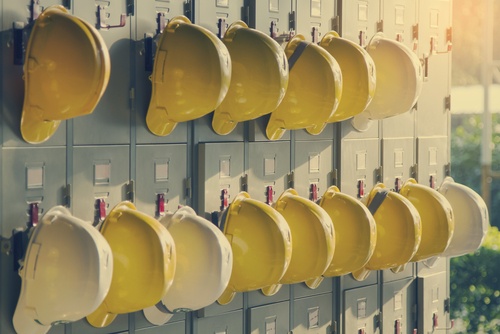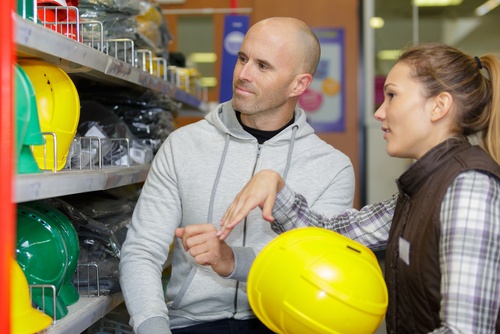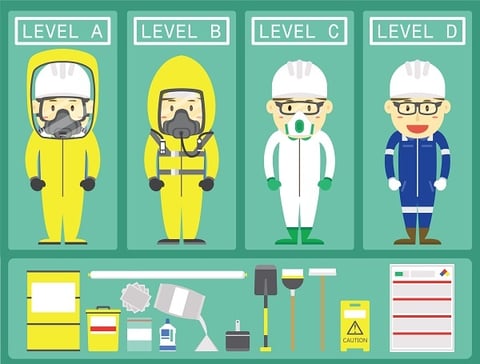Why Kitting Matters
If you’ve ever spent any time researching, sourcing and purchasing products of any kind, you’ve probably run across this term.
Kitting is only the most efficient and cost-effective way of purchasing your safety needs there is, that’s all. It’s a process in which individual products can be grouped, packaged and supplied together. The result is big time savings. Saving time, resources, labor hours and the big one...MONEY.
Not only that, but Kitting makes sure you have the equipment, tools, fittings, supplies and coordinating items on hand, when you need it. Build your custom safety kit here!

How Kitting Impacts Safety on the Job
Let’s just say you’ve done your job. You’ve assessed the work area, you’ve identified the risks and engineered out the hazards the best you can. Now it’s time to supply your crew with the safety equipment they need to do their job safely.
Kitting allows you the peace of mind of knowing that each piece of personal protective equipment (PPE) pairs with your safety program appropriately. Buying products this way helps you track inventory and know exactly what gear your crew is working with, at any given time.
Let's take a look at a few ways Kitting can improve safety in your company.

1. Productivity
Let’s not make this more complicated than it needs to be. Employees are more productive when they have the tools they need to do the job. Period.
Ever have one of your employees come to you saying they left their gloves at the office and drove off? Stepped on their safety glasses and cracked them? Or, do you have that one worker that loses everything, all the time? Without the gear, they can’t work. Keeping kits on site means they spend less time waiting on replacement items, more time getting the job done and kitting helps develop accountability.
Let’s pretend you have a new hire. He’s going through orientation right now. When he clocks in tomorrow he should be able to head straight to his locker and find his gear. Maybe that’s a hard hat and high-visibility vest, or a pair of coveralls and a respirator — either way, there’s no need to go searching online to piece it all together. All you gotta do is get him suited up and send him on down the hall for PPE training and get him to work.

2. Training & Standardization
Speaking of training, say you’re a purchasing and safety director for a large elevator installation and maintenance company. It’s a position you’ve had for many years and you know the players in the safety industry. You know what products you trust for your workers’ safety. So, maybe purchasing your PPE isn’t the problem, but making sure your entire crew knows the ins and outs of their gear is. A standardized kit will keep items the same.
Kits help employers effectively and successfully train their employees on the equipment that can save their lives. For example, it’s not enough to just use a fall protection harness and lifeline when necessary. Workers must know the limitations of each piece in the system. They should understand how their equipment may interact with other safety gear or in different conditions like humidity, oil or dust. Workers should be able to care for, maintain, inspect and know when their gear needs to be retired from service.
In fact, OSHA requires workers to know:
|
It’s a heck of a lot easier to train your crew when equipment is standardized across the board. Standardization can be as easy as color-coding — yellow cut-resistant glove vs. green impact-resistant glove, or as complex as Lockout Kits and Fall Protection Kits.

3. Total Cost of Ownership
Okay, let’s get down to brass tacks. Individually sourcing, purchasing and warehousing safety items and materials add up to huge costs for suppliers, which then rolls downhill to the buyer.
These are just a few examples of common supply chain costs:
|
|
Stop being penalized just for doing business. When you’re figuring out your budget and spending for the quarter, consider Kitting your safety needs. Kitting helps you minimize costs incurred by purchasing from multiple sources.
Ever buy a kid’s meal from one of those fast food joints? You get a little burger, some fries, a drink and a toy? Sounds good, right?
Now, imagine having to go to one restaurant for the cheeseburger, another for the French fries, the gas station for a drink and the toy store for a 3-pack of crayons. Not only does that sound incredibly frustrating, but you’ve now wasted gas and time. Plus, the burger is cold and your child just said they’re not hungry anymore.
Wait. Before you lose your cool, you don’t have to shop for safety gear that way. Having an all-in-one solution can fix all that — saving time, money, labor costs and headaches. Imagine ordering one item and all the needs for a new job show up!

4. Preparedness Response & Deployment
Be ready to act when trouble rears its ugly head.
You’ve gone through the mental gymnastics associated with hazard assessment. You understand what equipment you need to protect your workers. You’ve trained your crew on how to react in a worst case scenario. But, are you really ready to respond?
Having specialized kits on hand ensures you and your crew are able to tackle whatever comes your way.
Working near waterways and one of your rigs springs an oil leak? An oil spill kit can save the day, so you can clean the mess and get back to work.
Have a crew out on a remote location? When injury or illness strikes, you need to be able to offer fast and effective treatment. First aid kits are available that can handle any number of medical emergencies, from scrapes, cuts and bruises to full on cardiac arrest.
The reality is that you’ve got limited resources and limited hours in the day. You can keep on, keeping on the way you’re going. Or, you can try a better way and purchase all your safety needs in one place.
Let us know if we can make purchasing your safety supplies and equipment easier and more cost-effective.
Safety: It’s Your Life, It’s Our Business







